Abstract
Keywords: cell phonesemotional affinityetiquettes
1. Introduction
Over the last few decades, cell phones have become an innovative and developing technology in the world. Itacts as a tool for communication and emotional interaction among people of various ages. It has become an integral part in our lives as people find it convenient and very useful, making them more dependent on them. Cell phones have also not failed to lure the young generation (Hakoama and Hakoyana 2011). Adolescents are particularly inclined to trends, fashion and styles which make them more willing to adopt new technological devices and display various behavioural characteristics. A sense of belonging is strongly influenced by peer groups and adolescents to acquire a cell phone to maintain social relationships (Bryant, Jackson, et al. 2006). The cell phones help us to connect with our friends, access information from anywhere, to be productive and efficient and to capture memories and to be entertained (Meschtcherjakov 2009). They make us thus, more independent, by increasing our mobility and freedom (Lasen 2005).
Attachment is defined as a developmental process based on the adaptive tendency to maintain proximity, exchange of concept, care and pleasure to a familiar person or object (Bowlby 1969). Cell phone attachment is defined as a cognitive and emotional target-specific bond connecting a person’s self and the device. It has become an extended part of their owners especially when it is seen as linked to their identity. Being attached to a cell phone implies that this specific type of device has a special meaning to the owner. Owning an i-phone or Android contributes to defining their personality in the domain of material self and renders a particular identity. Cell phone attachment may emerge when the user appreciates his or her device and the role it plays in achieving certain goals. The device becomes meaningful, significant and serves as an object to fulfill the needs of its owner to support his or her self-image and self-esteem (Hendrike, et al. 2008).
The cell phone has also emerged as a symbol of support for the user as well as to the group that the user belongs to. It can serve to link the self to the past by providing memories like pictures, text messages and finally as an enhancement of personal power by providing necessary functions to live a modern life. There are four facets of a persons’ self scheme like diffuse self, private self, public self and collective self. Each facet provides a basis for self evaluation. Thus people become attached to objects because they help to define and maintain the self and serves to enhance a person’s feeling of self esteem. The diffuse self strives for body’s innate pleasure and pain response. This contains sensory pleasures experienced during usage, beautiful appearance, enjoying the familiarity of well known product. The private self aims at individual achievement by meeting personal standards. It reflects self-identity, individuality, independence, uniqueness, abilities, goals and achievements. The public self looks for approval by others, that consist of tokens of affection and appreciation from significant others such as gifts received from loved ones and on special occasions. The collective self searches for approval from the reference groups. People may strive to conform to these norms. Consumer product attachment implies the existence of an emotional tie between a person and an object that is considered to be special and is of great significance to that owner(Hamill 2005).
The degree of attachment is dependent on the intensity of the emotional reactions to the product. Cell phones are personalized objects, and it appears that emotional attachment owes as much to the development of the individual and their autopoiesis as to the connectivity that the cell phone affords. Cell phones are tools with which people maintain and manage their relationship. It provides a higher sense of security in potentially harmful situations (Wehmeyer 2007). Harlow’s research demonstrating attachment in infant monkeys highlights the important role that contact comfort provided by pleasurable tactile sensation is a powerful contributor in developing emotional attachment (Hout 2009). As we are social animals and we need to be respectful to one another, it is essential to be aware of the etiquette in using mobile phones. We must adopt ‘commonsense’ cell phone etiquette in using cell devices for communication. People’s tolerance levels are decreasing towards the mode of cell phone usage in meetings, college classroom on streets, in shopping malls and public transport systems, and at friends’ houses and thus requires attention. It is necessary to have its own code of conduct and implement few guidelines in its usage, because social norms for behavior in many places conflict with its use in public places. This aspect of cell phone use poses many challenges and is an avenue for research. It is important at the same time to recognize that not all cell phone usage in educational content is objectionable as nowadays m-learning and e-learning is implemented in teaching – learning process(Koutras 2006). There is difference in attitudes and personal characteristics that influences the perceptions regarding mobile phone use in educational setting. A widespread opinion of its careless usage is noted and in some instances has led to formulation of policies restricting mobile phones and its usage in classroom settings (Campbell 2007).
2. Research Objective
This study aims to investigate the factors that may influence the behavior of students with regard to cell phone usage, the emotional affinity towards their cell phones and determine the attitude and manner of etiquette while using cell phones.
3. Research Methods
The present study is a cross sectional survey conducted among all the students enrolled in the Gulf Medical University using a self administered questionnaire, after obtaining a documented approval from the University Ethics Committee. The Gulf Medical University is a private university that offers four undergraduate courses in Medicine, Pharmacy, Dentistry and Physical Therapy to students who have completed their higher secondary education. The university caters to students from more than fifty nationalities. For admission into the undergraduate programmes the students must have completed their higher secondary education. The study population were all students enrolled in Gulf Medical University, under the Colleges of Medicine, Dentistry, Pharmacy and Physical Therapy during the year 2012- 2013. An informed verbal consent was taken from the students. Only the undergraduate students willing to participate were included in the study. Students absent at the time of conduct of the survey and those unwilling to participate were excluded from the study.
A draft of a self administered anonymous questionnaire was developed by the authors and included items related to
i) Sociodemographic details,
ii) Psychosocial factors such as Social identity, Self esteem, Security, Family members, Peer groups,
iii) Behavior regarding usage with respect to Frequency of usage, Level of involvement, Attitude, Context of usage, Privacy, Dependency and Values
iv) Etiquette observed during use.
The draft was content and face validated by 2 experts in the field of emotional affinity and their comments were noted and incorporated in the final questionnaire.
Data collected was entered in Excel worksheet and was transferred an analysed using SPSS 20th version and employing the standard statistical tests.
4. Results
A total number of 140 students participated in the study.
Of the 140 questionnaires administered, 139 were analysed and 1 was excluded from the analysis due to incomplete entries.
Of the 139 students, 35 were males (25.2%) and 100 were females (71.9 %) and those of the middle eastern origin were 55 (39.6%) followed by Asians 37 (26.6%), Africans 22 (15.8%) and of Western origin 20 (14.4%), and 75 were ≤18 years (54%) and > 18 years were 58 (41.7%)
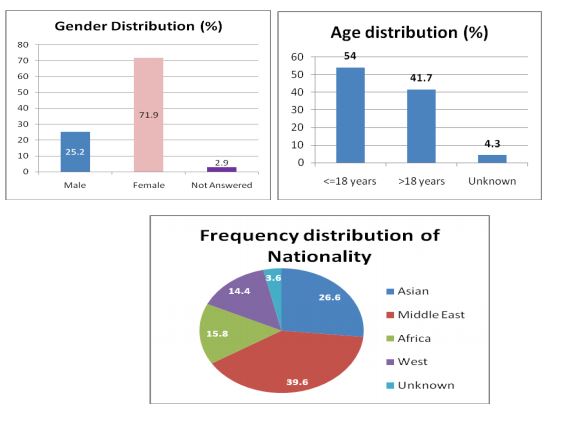
The age of acquiring the first cell phone in most students ( 92 – 66.2%) was 11-15 years while those who acquired it in ≤ 10 and ≥16 years were equal (22- 15.8%) . More than half the students (57.6%)possessed one cell phone while almost a third of the students had two cell phones and a small percentage (7.2%) were in possession of more than two cell phones.
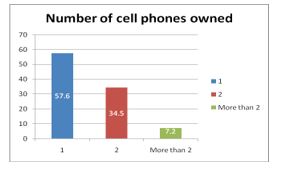
84.2% perceived that it was very important to possess a cell phone for use in emergencies, 62.6% felt the same to contact family, 58.2% for safety and security, 48.9% students felt it was a necessity, 40.3% used it to communicate with friends, 31.7% felt it was convenient, 25.2 % received as a gift and only 8.6% possessed a cell phone as they felt everyone has it and so they must too.
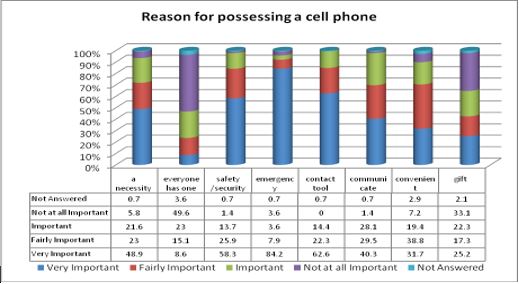
130 students rated the importance attached to the cell phone features that attract the users as another aspect of emotional affinity. The ability to use the MMS and WIFI was rated as the most important feature (100 students) , followed closely by the ease of texting in a given cell phone (90 students), while the least importance was attached to the availability of the radio(70 students)
The data for the reason for the emotional affinity to the cell phone was analysed under the domains of personal identity, emotional attachment, social connectivity and recreation or hobby pursuit. The association between emotional affinity and dependence on cell phone was found to be not significant.
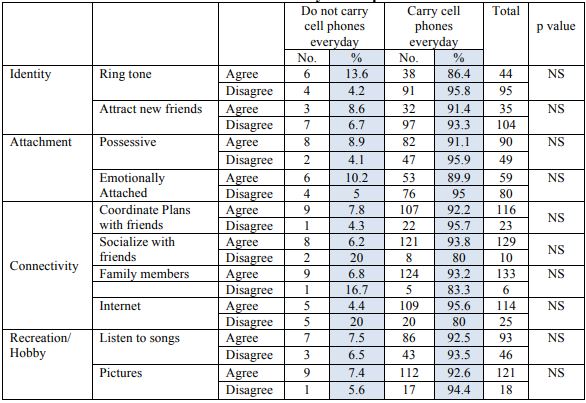
The etiquette of switching the cell phone to a silent mode was observed by 96.4 % of the students while 12.2% of them
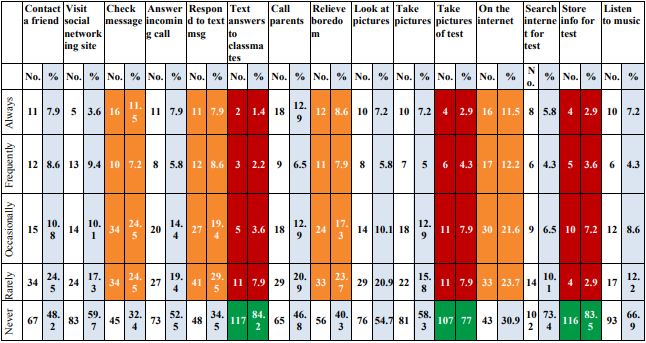
68% of the students use the cell phones during academic sessions to check messages and 67% browse the internet and 64% to respond to messages while 57 % use it to relieve boredom.
The reasons for use of cell phones in academic sessions when compared in the two groups (one which uses and the other which never does) it is seen that most of them (69%) use it to access the internet and the least common reason is (15.1%) . However it is seen that about 23% of them claim to have used it to take pictures of a test , 16.6% use it to store info for tests and 15.1% use it to text answers to their friends. Though these percentages appear to be smaller compared to the whole, they are alarming due to their ethical implications.
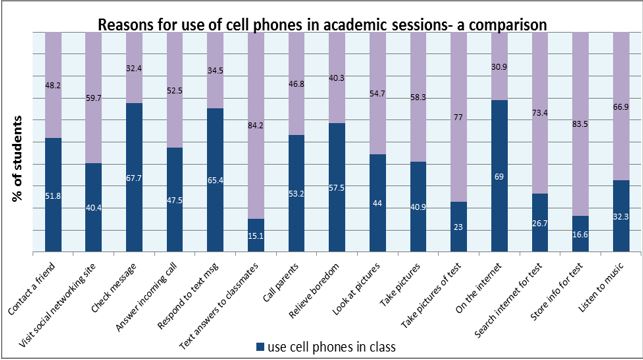
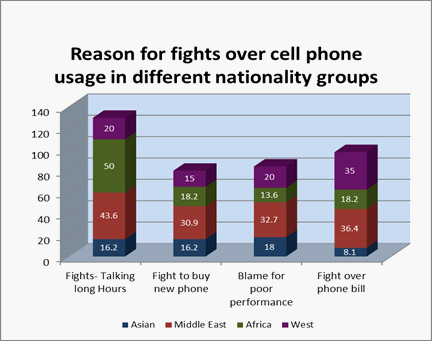
The reason of the fights most frequently being talking for long hours (50% of African and 43.6% Middle eastern ). The fights over phone bills most frequently occurred in students belonging to the middle eastern (36.4%) and the western nationalities( 35%) and fights over cell phones being blamed for poor academic performance was seen most frequently in the middle eastern nationalities (32.7%) and were the fights to by new phones (30.9%). The association of nationality to fights for talking long hours and over phone bills were found to be significant

The fights were more frequent among the female students (103 students) as compared to the male (38 students). The most frequent cause of te fight was poor academic perfomance in males (31.4%) and talking for long hours in females (38%). The association however was not found to be significant.
The most frequent mode of use of the cel phone was in the silent mode during class hours by 84.2% of the students as opposed to the switched on mode by 12.2%.
The number of students who observe the etiquettes of cell phone use were analysed according to age groups and gender and differences were noted. The differences were however not significant except for avoiding personal topics and avoiding intimate conversation in public places where the students 18 years and younger scored higher. Gender differences were not significant.
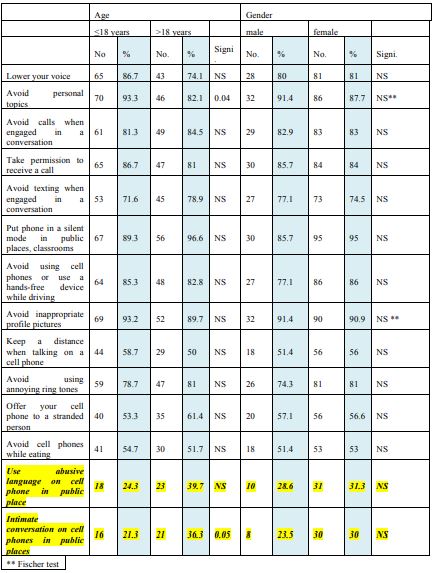
Discussion
A study conducted by Lee showed that cell phones were viewed as a necessity and were important for communication, security and for seeking information. In our study most students felt it was important to be in the possession of a cell phone for use in emergencies. The study showed that females were more likely to carry cell phones for safety reasons (Lee, et al.2009).. Most students acquired their first phones in the adolescent age which was also found in a study conducted by Ling, where the reason stated was that the participants in that age group had for the first time started to live or spent greater time out of their own homes and need to build connections with people other than their family (Ling 2010). A study showed that the adolescents were particularly inclined to follow trends and fashions, however in our study it was the least frequent reason cited for possession of a cell phone (Ling 2001). A large number of participants in our study indicated their possessiveness and emotional attachment to the device. A similar finding was cited in a qualitative study from Australia, which stated that the adolescents had a very strong attachment to their cell phones (Walsh,et al. 2008). A study conducted by Chen, showed that the participants preferred MMS over text messages to communicate with their family member. However, this difference was not found for friends, quite similar to our study where the participants also rated MMS/ Wifi to be very important in a cell phone. The study also found that the participants used their cell phones more frequently to call their mothers than their fathers (Chen, et al. 2009). In another study cell phones were found to be an aid in a stronger parent-teen relationship where parents were actively involved in the activities of their adolescents through the medium of cell phones (Weisskirch 2009). The social group that is most frequently contacted using a cell phone were the parents in our study has found in another study by (Ling in 2010). A very large cohort of the study group used the cell phone to take photos and use it to relive memories with family and friends, a finding that is found to be similar to a study that further endorsed that this made sharing the moments with friends by the MMS feature of the cell phone more rewarding (Koskinen 2008). Studies show that adolescents use cell phones most frequently for SMS (text messaging), gaming, picture messaging, and “moblogging” (mobile blogging), a finding reflected in our study as well (Ling 2002).Adolescents very commonly use cell phones to communicate with their peers. A study conducted among students showed that 54% of the participants used text messaging to socialize with peers. This finding was also found in our study where 70 % students used it to communicate with their peers (Lenhart, and Campbell, et al. 2010).Importance given to advanced cell phone features is a determining factor in the purchase of cell phones and also contributes to cell phone dependence. In our study the features that enable better communications were rated highest, as found in a study (Valor and Sieber 2003).
In our study it was found that nearly all students carried their cell phones everyday, which reflected their dependence on their electronic devices. This dependence stems from excessive use of the device which then integrates in their daily life to such an extent that it induces addiction behavior and dependence (Walsh, et al. 2008). Dependence however comes at a cost and could lead to friction between the user and the financer, which in our study are the parents. The most frequent cause of fights are long hours of talking on cell phones and consequently a higher phone bill, a finding that is similar to a study conducted by (Geser 2006) The usual mode of use of cell phones in classroom settings in our study was that of the silent type. Studies have shown that class rooms are among the least tolerable spaces for cell phone use (Katz 2005). Use of cell phones for purposes other than studies in the classroom is found in another studies and it also states that 85% of instructors felt that a ban on their use in the classrooms must be in place. A disturbing fact also reported is the use of cell phones for cheating purposes, though in our study it is reported by a smaller percentage of the participants (Ling 2003). A survey conducted by Intel showed that among the leading inapt cell phone etiquettes were talking loudly in public places and being unaware of surroundings while using the device (Sawsou 2013). In our study we found that there
were differences in the etiquettes followed in public places, but these were not significant generally. However, the evasion of intimate conversations in public places was significantly more frequent among participants below 18 years of age.
6. Conclusions
-
Students use cell phone for maintaining social identity, self esteem, security and connectivity with friends and family
-
Emotional attachment to the device and the information stored also leads to a convinced level of anxiety and reassurance in events of loss or emergencies
-
The study of attitude have increasingly indicated their possessiveness and dependence on the device
-
There is a marked difference in the etiquette and usage of device among students in various situations
Limitations
Academic use and effects were not a part of the study Inherent limitations of a cross-sectional survey
References
- Bowlby, J. (1969). “Attachment and loss”. NewYork, Basic books.. Available on. , http://www.amazon.com/Attachment-Volume-Basic-Books-Classics/dp/0465005438
- Bryant, J. A.Jackson, A. (2006). “IMing, text messaging and adolescent social networks”. JCMC .. Available on. , 11(2), http://jcmc.indiana.edu/vol11/issue2/bryant.htm
- Campbell, S. W. (2007). “Perceptions of mobile phones in college classrooms: Ringing, Cheating and Classroom policies”. International journal of communication 1: 738-757 Available on http, ijoc.org/ojs/index.php/ijoc/article/download/169/112
- Chen, Y.Katz, J. E. (2009). “Extending family to school life: College students’ use of the mobile phone”. IJHCS 67: 179-191
- Chóliz, M. (2010). “Mobile phone addiction: Point of issue”. Addiction, 105(374)
- Geser, H. ( 2006). “Pre-teen cell phone adoption: Consequences for later patterns of phone usage and involvement”. Sociology in Switzerland: Sociology of the Mobile phone.. Available at. , http://socio.ch/mobile/t_geser2.pdf
- Hakoama, M.Hakoyana, S. ( 2011). “The impact of cell phone use on social networking and development among college students”. AABSS Journal 15: 1-20 Available on 2011/05/Hakoma Final.pdf, http:// aabss.org/journal
- Hamill., (2005). “Mobile world: Past,.Present and Future”.. USA, Springer Available on http. , springer.com/computer/hcibook/978-1-85233-825-1
- Hendrike , N. J. ( 2008). “Consumer- Product attachment: Measurement and design implications”.
- (), International Journal of Designs 2( 3) :2-3.Available on http://www.ijdesign.org/ojs/index.php/i/design/article/viewfile/325/205
- Hout, M. ( 2009). “Sustaining the human object relationship – Design and Emotion”. Available on the human - object – relationship/, http://www.design-emotion.com/2009/07/24/sustaining
- Katz, J. E. ( 2005). “Mobile phones in educational settings”. In (Ed.), A sense of place: The gobal and the local in mobile communication : 305-317, K. Nyiri
- Koskinen, I|, Katz, (2008). “Mobile multimedia: Uses and social consequences. Handbook of mobile communication studies”. Cambridge, MA: 241-256.. Available at: http://wwwpdf. , 2(uiah.fi/~ikoskine/recentpapers/mobile_multimedia/mobilemultimediainsociety), J. E
- Koutras, E. ( 2006). “The use of mobile phones by generation Y students at TwoUniversities in the city of Johannesburg”. University of South Africa.. Available on ;jsessionid=92F80D75C328 9B650CA6CDCEB49BC14E?sequence=1. , http://uir.unisa.ac.za/bitstream/handle/10500/717/dissertation.pdf
- Lasen, A. (2005). “Understanding mobile phone users and usage”. Vodafone group R and D.Available on mobile phone users and usage.pdf, http://eprints.ucm.es/6477/1/WFS4-Understanding
- Lee, S.Meszaros, P. S.Colvin, J. ( 2009 ). “Cutting the wireless cord: College student cell phone use and attachment to parents”. Marriage and Family Review 45: 717-739
- Lenhart, A.Ling, R.Campbell, S. ( 2010). “Teens and mobile phones”. Pew Internet and American Life Project.. Available from. , http://www.pewinternet.org/
- Ling, R. ( 2001). “Adolescent Girls and young adult men: Two subculture of the mobile telephone”.
- KjellerTelenor Research and development , R. (2001), Adolescent.pdf
- Ling, R. ( 2002). “Adolescent girls and young adult men: Two subcultures of the mobile telephone”. Revista de E studios de Juventud.. Available at. , 57(2), 33-46, http://www.itu.int/osg/spu/ni/ubiquitous/Papers/Youth_and_mobile_2002.pdf
- Ling, R. ( 2003). “The impact of the mobile telephone on four established social institutions”. Telenor R&D. Available online, http://www.telenor.no/fou/program/nomadiske/articles/03.pdf
- Ling, R. (2010). “Texting as a life phase medium”. JCMC, 15(277-292)
- Ling, (2010). “Texting as a life phase medium”. Journal of Computer-Mediated Communication, 15(277-292)
- Menda, L. Mobile Etiquette Survey UAE , Published and available on: http://blogs.intel.com Meschtcherjakov, A., ( 2009). “Mobile attachment – Emotional attachment towards mobile devices and services”.
- (), Bonn, Germany, Mobile HCI. Available on http:// mobileci.uni- siegen.de/proceedings 2009/dc 412- meschtscherjakov.pdf
- Sawsou, N. (2013). “Where are your mobile manners? Intel survey reveals UAE users believe we lack mobile etiquette”.
- Olca, I. L. E. ( 2006). “Personal and Ubiquitous Computing”. Journal of Social Psychology, 146( 3), 261-274
- Valor, J. ( 2003). “Uses and attitudes of young people toward technology and mobile telephony”. Universidad de Navarra
- Walsh , S. P.Ross, M. ( 2008). “Over-connected? A qualitative exploration of the relationship between Australian youth and their mobile phones”. Journal of Adolescence 31: 77-92
- Walsh, S. P.White, K. M.Ross , M. Y. ( 2008). “Over-connected? A qualitative exploration of the relationship between Australian youth and their mobile phones”. Journal of Adolescence 31: 77-92
- Wehmeyer, K. ( 2007). “Assessing users’ attachment to their mobile devices”. Toronto ICMB.. Available on. , http:ieeexplore.ieee.org/xpi/freeabs-all.jsp?arno-4278560
- Wei , R.Leung, L. ( 1999). “Blurring public and private behaviors in public space: Policy challenges in the use and improper use of the cell phone”. Telematics and Informatics 16: 11-26
- Weisskirch, R. S. ( 2009). “Parenting by cell phone: Parental monitoring of adolescents and family relations”. Journal of Youth Adolescence, 38(1123-1139)
Copyright information

This work is licensed under a Creative Commons Attribution-NonCommercial-NoDerivatives 4.0 International License.
About this article
Publication Date
14 May 2014
Article Doi
eBook ISBN
978-1-80296-000-6
Publisher
Future Academy
Volume
1
Print ISBN (optional)
-
Edition Number
1st Edition
Pages
1-236
Subjects
Social psychology, collective psychology, cognitive psychology, psychotherapy
Cite this article as:
Taroor, R., Ahmed, M., Mathew, L. S., & Sreedharan, J. (2014). Emotional Affinity Towards Cell Phones Among University Students in UAE. In Z. Bekirogullari, & M. Y. Minas (Eds.), Cognitive - Social, and Behavioural Sciences – icCSBs 2014, vol 1. European Proceedings of Social and Behavioural Sciences (pp. 6-19). Future Academy. https://doi.org/10.15405/epsbs.2014.05.3

